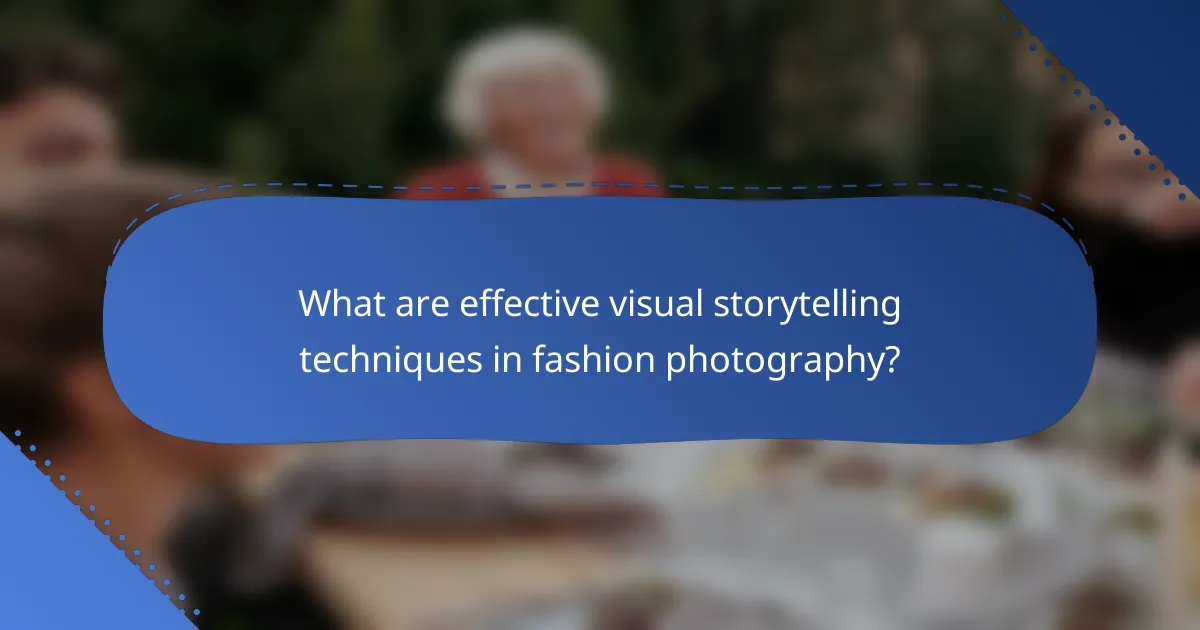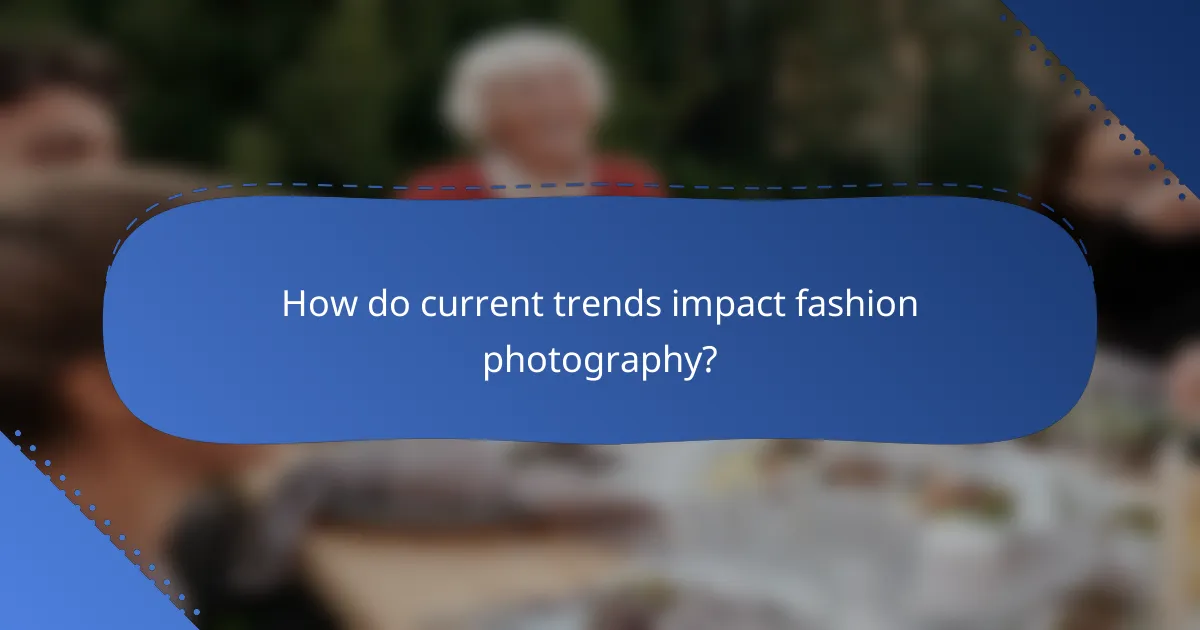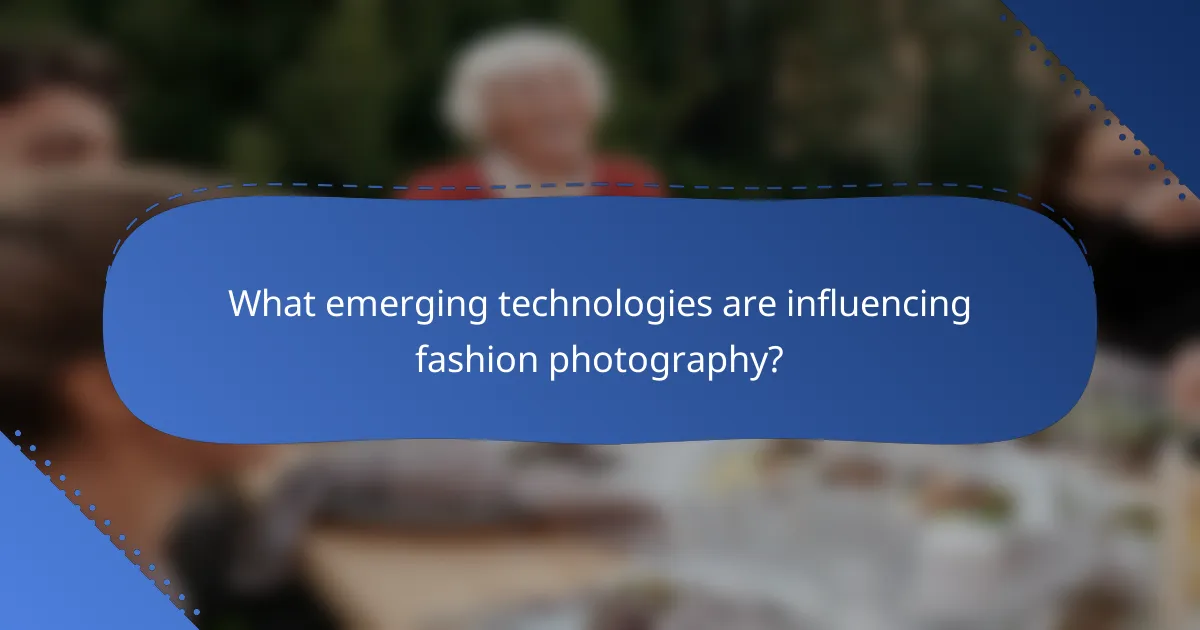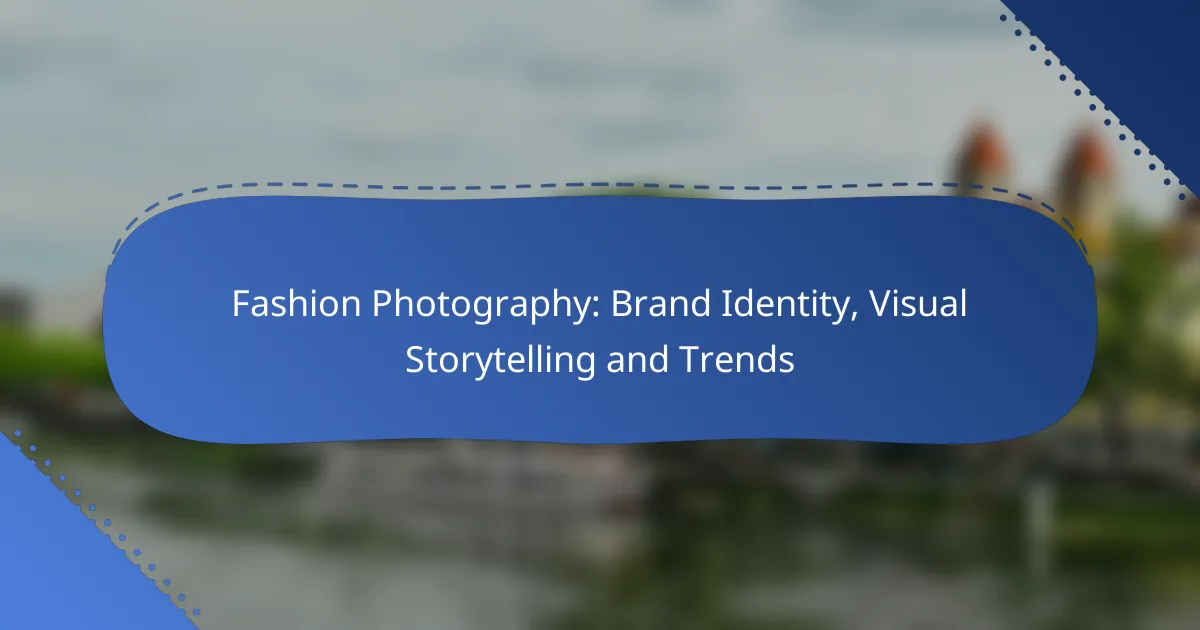Fashion photography is essential in defining a brand’s identity, as it visually encapsulates its values, style, and personality. By employing effective visual storytelling techniques and adapting to current trends, photographers can create compelling narratives that resonate emotionally with audiences, ultimately distinguishing brands in a competitive market.

How does fashion photography shape brand identity?
Fashion photography plays a crucial role in shaping brand identity by visually communicating a brand’s values, style, and personality. Through carefully curated images, brands can create a distinct image that resonates with their target audience and differentiates them from competitors.
Visual consistency across campaigns
Maintaining visual consistency across campaigns is essential for reinforcing brand identity. This involves using a cohesive color palette, typography, and photographic style that aligns with the brand’s overall aesthetic. For instance, a luxury fashion brand may opt for high-contrast, polished images, while a streetwear label might favor gritty, urban settings.
To achieve this consistency, brands should develop a style guide that outlines key visual elements and ensure all campaigns adhere to these guidelines. This approach not only strengthens recognition but also builds trust with consumers who come to associate specific visual cues with the brand.
Emotional connection through imagery
Fashion photography can evoke emotions and create a deeper connection between the brand and its audience. By telling a story through images, brands can engage consumers on a personal level, making them feel more invested in the brand’s narrative. For example, a brand might showcase its clothing in a lifestyle setting that reflects the aspirations of its target demographic.
Using relatable models and authentic scenarios can enhance this emotional connection. Brands should consider the feelings they want to evoke and select imagery that aligns with these emotions, whether it be joy, empowerment, or nostalgia.
Influence of style on brand perception
The style of fashion photography significantly influences how consumers perceive a brand. A polished, high-fashion aesthetic may position a brand as exclusive and luxurious, while a more casual, candid approach can suggest accessibility and relatability. Understanding the target audience is key to selecting the appropriate style.
Brands should also be aware of current trends in fashion photography, such as the rise of sustainability and inclusivity, which can impact consumer perceptions. Adapting to these trends while remaining true to the brand’s core identity can help maintain relevance in a competitive market.

What are effective visual storytelling techniques in fashion photography?
Effective visual storytelling techniques in fashion photography include creating a cohesive narrative, integrating lifestyle elements, and utilizing color theory to evoke specific moods. These techniques help convey a brand’s identity and connect with the audience on an emotional level.
Use of narrative arcs
In fashion photography, narrative arcs are essential for guiding the viewer through a story. A well-structured narrative can include elements like a beginning that introduces the theme, a middle that develops the story, and an end that resolves it. This structure can be achieved through a series of images that depict a progression or transformation.
Consider using a storyboard to outline the key moments in your visual narrative. This helps ensure that each shot contributes to the overall story, maintaining viewer engagement. For instance, a fashion shoot could follow a character’s journey from day to night, showcasing different outfits that reflect changing moods and settings.
Incorporation of lifestyle elements
Incorporating lifestyle elements in fashion photography enhances relatability and context. This can involve featuring models in everyday settings or engaging in activities that resonate with the target audience. By showcasing fashion within a lifestyle framework, the images become more aspirational and accessible.
For example, a campaign for casual wear might depict models enjoying a picnic or a day at the beach. These scenarios not only highlight the clothing but also create a narrative that potential customers can envision themselves in, making the brand more appealing.
Color theory and mood setting
Color theory plays a crucial role in setting the mood and tone of fashion photography. Different colors evoke various emotions and can significantly influence how a viewer perceives a brand. For instance, warm colors like red and orange can convey energy and passion, while cool colors like blue and green often evoke calmness and serenity.
When planning a shoot, consider the emotional response you want to elicit and choose a color palette that aligns with that goal. Additionally, using contrasting colors can create visual interest and draw attention to specific elements within the frame, enhancing the overall storytelling aspect.

How do current trends impact fashion photography?
Current trends significantly shape fashion photography by influencing aesthetics, themes, and the overall approach to visual storytelling. Photographers must adapt to these trends to resonate with audiences and effectively communicate brand identity.
Rise of social media influencers
Social media influencers have transformed fashion photography by prioritizing relatable and engaging content. Brands often collaborate with influencers to create authentic imagery that connects with their followers, leading to increased visibility and engagement.
This trend emphasizes the importance of personal branding, where influencers showcase their unique styles and narratives. Photographers should consider how to capture these personal stories while aligning with the brand’s message.
Emphasis on sustainability in visuals
Sustainability has become a crucial theme in fashion photography, reflecting a growing consumer demand for eco-friendly practices. Photographers are now tasked with portraying sustainable fashion in a way that highlights ethical sourcing and environmentally conscious production.
Incorporating natural settings, using recycled materials, and promoting brands that prioritize sustainability can enhance the visual narrative. Photographers should aim to create imagery that not only showcases products but also tells a story of environmental responsibility.
Shift towards authenticity and diversity
There is a notable shift towards authenticity and diversity in fashion photography, moving away from traditional beauty standards. This trend encourages the representation of various body types, ethnicities, and backgrounds, making fashion more inclusive.
Photographers should focus on capturing genuine moments and emotions, rather than overly staged scenes. This approach not only appeals to a broader audience but also aligns with contemporary values of inclusivity and representation in fashion.

What are the key criteria for selecting a fashion photographer?
When selecting a fashion photographer, consider their portfolio, experience with similar campaigns, and technical skills. These factors will help ensure that the photographer aligns with your brand’s identity and can effectively convey your visual storytelling goals.
Portfolio relevance to brand style
A photographer’s portfolio should reflect a style that resonates with your brand’s identity. Look for consistency in aesthetics, color palettes, and themes that match your vision. For example, if your brand focuses on high-fashion editorial looks, ensure the photographer has similar work in their collection.
Reviewing a variety of projects within their portfolio can also provide insight into their versatility and ability to adapt to different styles. This is crucial for maintaining a cohesive brand image across various campaigns.
Experience with similar campaigns
Experience in executing campaigns similar to yours is vital for a successful collaboration. A photographer who has worked with brands in your niche will understand the nuances of your target audience and market trends. This familiarity can lead to more effective visual storytelling.
Ask for case studies or references from previous clients to gauge their success in similar projects. This will help you assess their ability to deliver results that align with your brand’s objectives.
Technical skills and equipment
The technical skills and equipment a photographer possesses can significantly impact the quality of the final images. Ensure they are proficient in using professional-grade cameras and lighting setups suitable for fashion photography. This includes knowledge of studio and outdoor shooting techniques.
Additionally, inquire about their post-production capabilities. A photographer who is skilled in editing software can enhance the final product, ensuring it meets the high standards expected in the fashion industry. Consider discussing specific techniques they use to achieve the desired look for your brand.

How can brands leverage fashion photography for advertising?
Brands can effectively leverage fashion photography for advertising by creating visually striking images that resonate with their target audience. This approach not only enhances brand identity but also tells a compelling visual story that engages consumers and drives sales.
Creating compelling ad campaigns
To create compelling ad campaigns, brands should focus on high-quality fashion photography that aligns with their brand values and messaging. This includes selecting models, settings, and styles that reflect the brand’s identity and appeal to its audience.
Incorporating storytelling elements into the visuals can enhance emotional connections. For example, a campaign for a sustainable fashion brand might showcase models in natural settings, emphasizing eco-friendliness and authenticity.
Utilizing digital platforms effectively
Brands must choose the right digital platforms to showcase their fashion photography, as different channels attract varied audiences. Instagram and Pinterest are particularly effective for visual content, allowing brands to reach fashion-forward consumers.
Utilizing features like shoppable posts can streamline the purchasing process, making it easier for consumers to buy products directly from the images they see. Regularly updating content and engaging with followers can also enhance brand visibility and loyalty.
Measuring impact through analytics
To measure the impact of fashion photography in advertising, brands should utilize analytics tools that track engagement metrics such as likes, shares, and comments. These insights can help identify which images resonate most with the audience.
Additionally, monitoring conversion rates from campaigns can provide valuable data on how effectively the photography drives sales. Brands should regularly review these metrics and adjust their strategies accordingly to optimize future campaigns.

What emerging technologies are influencing fashion photography?
Emerging technologies such as artificial intelligence, augmented reality, and advanced imaging techniques are significantly shaping fashion photography. These innovations enhance creative possibilities, streamline workflows, and improve audience engagement.
Artificial Intelligence in Fashion Photography
Artificial intelligence (AI) is transforming fashion photography by automating editing processes and enhancing image quality. AI tools can analyze vast amounts of data to predict trends, allowing photographers to tailor their work to current consumer preferences.
For example, AI-driven software can suggest optimal lighting and composition based on successful past campaigns. This not only saves time but also helps photographers maintain a competitive edge in a rapidly evolving market.
Augmented Reality and Virtual Reality
Augmented reality (AR) and virtual reality (VR) are creating immersive experiences in fashion photography. These technologies allow brands to showcase their collections in interactive formats, enabling customers to visualize products in real-world settings.
For instance, AR apps can let users try on clothing virtually, enhancing the shopping experience. This engagement can lead to higher conversion rates and customer satisfaction, making it a valuable tool for fashion brands.
Advanced Imaging Techniques
Advanced imaging techniques, such as 3D imaging and high-resolution photography, are elevating the quality of fashion photography. These methods provide detailed visuals that capture the texture and intricacies of garments, appealing to discerning consumers.
Photographers can utilize techniques like photogrammetry to create 3D models of clothing, offering a unique perspective that traditional photography cannot achieve. This innovation allows for more dynamic presentations in both online and offline marketing materials.
